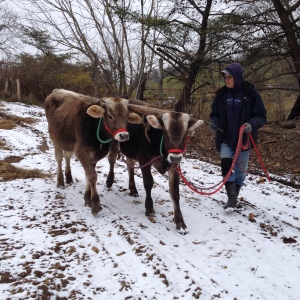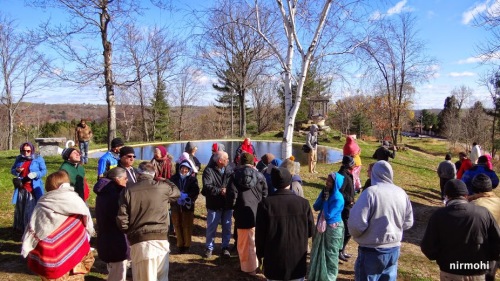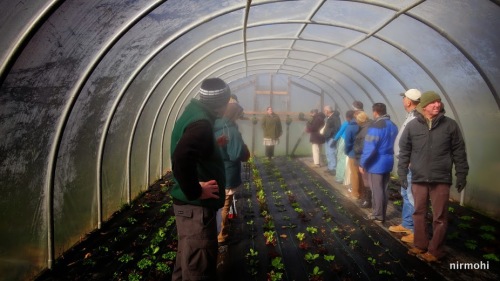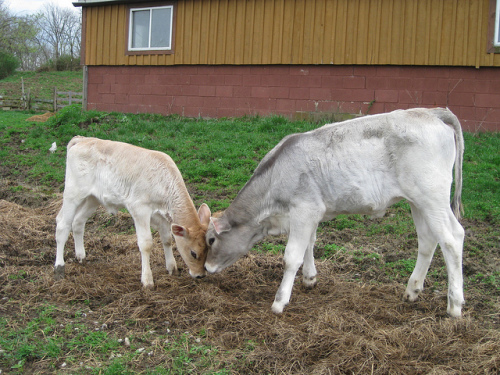New Vrindaban Community Parikrama Showcases Exciting Developments
New Vrindaban Fall Board Meetings 2014:
Community Parikrama Showcases Exciting Developments
By Madhava Smullen
On November 2nd, after spending the previous day hearing presentations on New Vrindaban’s many departments, board and community members wrapped up this fall’s meetings by seeing some of the latest developments for themselves in an enlivening community parikrama.
At 10:00am, around twenty-five people stepped out into a crisp but brilliantly blue and sunny morning and made their way first to the old barn at Bahulaban, which had fallen into a severely dilapidated condition over thirty years but is now being rebuilt as a new ox training center.
Renovation project manager Vyasasana Das spoke about his work on the barn, which has been given a brand new wood frame over its original core structure. He indicated the spaces on the first floor where there will be hay storage and corrals for oxen, and on the second floor where there will be living quarters for people working with the ox program.
Daivata Das, who worked with oxen when Prabhupada was physically present and is back to carry out the same service, showed everyone the training area at the back of the barn, and spoke about how he hopes to have the young oxen pulling a cart next year. He was clearly brimming with enthusiasm at getting to serve the community in this way again.
Meanwhile New Vrindaban pioneers Madhava Gosh and Advaita Das told stories about how devotees lived in the barn with their families in the early days, and how Advaita’s son was born there.
Madhava Gosh and his wife Vidya, who received an appreciation plaque to take home the previous day, were then presented with another public plaque which will remain permanently affixed to the new ox barn. “In recognition of more than four decades of service rendered to the cows and gardens of New Vrindaban by Madhava Gosh Dasa and Vidya Dasi,” it reads, “The Board of Directors of Eco-Vrindaban hereby renames this building the Madhava Gosh-alla.”
After everyone had a good chuckle at its pun-tastic new name, the ox program’s spiritual advisor Varshana Swami reminded them that the barn also had great spiritual significance. “It’s the last place built by devotees that Srila Prabhupada visited in Bahulaban,” he said. “And now, it’s getting a second life.”
Next, the tour moved on to the hilltop Radha Gopinath Mandir. Still under construction, it’s set to be a small replica of the original temple in Vrindavan, India. Varshana Swami, who is overseeing the project, pointed out the Radha Gopinath Deities residing in an elegant gazebo nearby, and said that They would move into Their temple once it is completed.
He then explained the history of the project, outlining Srila Prabhupada’s instructions to build not only seven replicas of Vrindavan’s seven main temples, but also replicas of its sacred lakes. He showed the group two of these replica lakes, Radha Kunda and Lalita Kunda, and spoke about the pastimes Krishna performed at them, while community president Jaya Krishna Das cheerfully sprinkled everyone with their sacred waters.
The tour also inspected a computer-generated image of the Radha-Gopinath Mandir, with Raghunath Das Goswami’s bhajan kutir and Radha-Kunda next to it.
“Please offer your blessings and prayers that Srila Prabhupada’s vision will unfold more and more,” Varshana Swami requested the assembled devotees.
From Radha-Gopinath Mandir, the parikrama went on to the Garden of Seven Gates. Garden manager Kacey Orr showed everyone the new greenhouse for in-ground planting, where greens will continue to be harvested until February and will last the Temple through much of winter.
She also took the tour through the recently renovated flower greenhouse, which was dormant but will see an astonishing twenty to thirty thousand flowers grown there throughout the 2015 growing season.
Walking through the open fields in the Garden of Seven Gates, Kacey talked about the crops grown there, including tomatoes, peppers, Chinese cabbage, green beans, pumpkins, watermelon, squash, ten-foot-high sunflowers, and marigolds, which were still growing in a golden carpet across the ground.
“Every time we pick, there are fifty gallons of marigolds,” Kacey said, before pointing out the area where a brand new rose garden, exclusively for the Deities, will be grown next year.
Kacey’s last stop was the smaller Teaching Garden, a cosy haven for herbs and flowers encircled by a newly-built honey-colored fence and gates. A regular site for guest tours, its centerpiece is an attractive wooden pergola where devotees can chant or make garlands, and guests can relax and soak up the peaceful environment.
“Next spring we will be taking it up to show-level, and putting signs in every bed so that guests know what they’re looking at,” said Kacey.
Finally, the tour visited the community’s milking barn where nine Brown Swiss cows are milked, passing through the new swing and large decorative flower planters at the entrance. Inside, cowherds Ananda Vidya and his wife Lalita Gopi pointed out the new extension to the feeding aisle, and the new enclosed loafing area for the cows to relax in a dry, hay-covered space.
The weekend ended with a beautiful pushpanjali ceremony honoring Vaishnava acharya Gaura Kishora Das Babaji on his disappearance day. Afterwards, as they tucked into an Ekadasi Sunday Feast, all the devotees excitedly discussed everything they had seen and heard, inspired to continue their service with renewed energy and support New Vrindaban in its ongoing growth.







